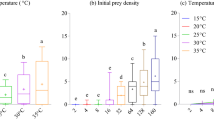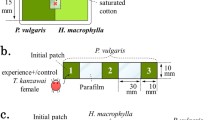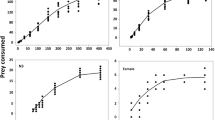Abstract
Masking, a type of camouflage, has been argued to function as an anti-predator mechanism helping to avoid detection or recognition by a prey or predator. However, research focused on the effects of masking on life history traits is scarce. We evaluated under laboratory conditions whether developmental time and survivorship in the absence of predators, and the probability to be predated by a potential predator are affected when the blood-feeding triatomine Mepraia spinolai masks with sand particles. Theoretically, it is expected to find a positive anti-predator effect of masking and the presence of trade-offs between development time and survival. We assigned M. spinolai nymphs to a masked or non-masked treatment and subjected them to a lizard, a potential predator. Results show masked nymphs reach the fifth instar faster and survive longer than non-masked nymphs, which is inconsistent with the trade-offs hypothesis we expected to find. In predation experiments, higher number of masked nymphs detected lizards before lizards detected them compared to non-masked nymphs. We suggest that masking may be an adaptation to the extreme climatic conditions the nymphs must face, and seems to render selective advantages to M. spinolai nymphs even in the absence of selective forces.



Similar content being viewed by others
References
Ambrose DP (1986) Impact of nymphal camouflaging on predation and cannibalism in the bug Acanthaspis siva. Env Ecol 4:19–200
Berke SK, Woodin SA (2008) Energetic costs, ontogenic shifts and sexual dimorphism in spider crab decoration. Funct Ecol 22:1125–1133
Botto-Mahan C, Cattan PE, Canals M (2002) Field tests of carbon dioxide and conspecifics as baits for Mepraia spinolai, vector of Chagas disease. Acta Trop 82:377–380
Botto-Mahan C, Ortiz S, Rozas M, Cattan P, Solari A (2005) DNA evidence of Trypanosoma cruzi in the Chilean wild vector Mepraia spinolai (Hemiptera: Reduviidae). Mem Inst Oswaldo Cruz 100:237–239
Botto-Mahan C, Cattan PE, Medel R (2006) Chagas disease parasite induces behavioural changes in the kissing bug Mepraia spinolai. Acta Trop 98:219–223
Brandt M, Mahsberg D (2002) Bugs with a backpack: the function of nymphal camouflage in the West African assassin bugs Paredocla and Acanthaspis spp. Anim Behav 63:277–284
di Castri F, Hajek ER (1976) Bioclimatología de Chile. Ediciones de la Universidad Católica de Chile, Santiago
Ehrenfeld MJ, Canals M, Cattan PE (1998) Population parameters of Triatoma spinolai (Heteroptera: Reduviidae) under different environmental conditions and densities. J Med Entomol 35:740–744
Eisner T, Carrel JE, Van Tassel E, Hoebeke ER, Eisner M (2002) Construction of a defensive trash packet from sycamore leaf trychomes by a chrysopid larva (Neuroptera: Chrysopidae). Proc Entomol Soc Wash 104:437–446
Endler JA (1978) A predator’s view of animal color patterns. Evol Biol 11:319–364
Endler JA (1986) Defense against predators. In: Feder ME, Lauder GV (eds) Predator–prey relationships: perspectives and approaches from the study of lower vertebrates. University of Chicago Press, Chicago, pp 109–134
Haridass ET, Balu A, Morrison MN (1987) Feeding and behavioural parameters and egg ultrastructure in the biosystematics of Reduviidae (Insecta-Heteroptera). Proc Indian Acad Sci (Anim Sci) 96:485–497
Hultgren KM, Stachowicz JJ (2008) Alternative camouflage strategies mediate predation risk among closely related co-ocurring kelp crabs. Oecologia 155:519–528
Jackson RR, Pollard SD (2007) Bugs with backpacks deter vision-guided predation by jumping spiders. J Zoo 273:358–363
Kollien AH, Schaub GA (2000) The development of Trypanosoma cruzi in Triatominae. Parasitol Today 16:381–387
Lent H, Wygodzinsky P (1979) Revision of the triatominae (Hemiptera: Reduviidae) and their significance as vectors of Chagas disease. Bull Am Mus Nat Hist 163:130–138
Lent H, Jurberg J, Galvão C (1994). Revalidaçao de genero Mepraia Mazza, Gajardo and Jörg (1940) (Hemiptera, Reduviidae, Triatominae). Mem Inst Oswaldo Cruz 89:347–352
McMahan EA (1982) Bait-and-capture strategy of a termite-eating assassin bug. Insect Soc 29:346–351
McMahan EA (1983) Adaptations, feeding preferences, and biometrics of a termite-baiting assassin bug (Hemiptera: Reduviidae). Ann Entomol Soc Am 76:483–486
Merilaita S (2003) Visual background complexity facilitates de evolution of camouflage. Evolution 57:1248–1254
Odhiambo TR (1958) Some observations on the natural history of Acanthaspis petax Stål (Hemiptera: Reduviidae) living in termite mounds in Uganda. Proc R Entomol Soc A 33:167–175
Otto C, Svensson BS (1980) The significance of case material selection for the survival of caddis larvae. J Anim Ecol 49:855–865
Reznick D (1985) Cost of reproduction: an evaluation of the empirical evidence. OKIS 44:257–267
Richner H, Milinski M (2000) Note on the functional significance of masking behaviour in sea urchins-an experiment with Paracentrotus lividus. Mar Ecol Prog Ser 205:307–308
Ruxton GD, Sherratt TN, Speed MP (2004) Avoiding attack: the evolutionary ecology of crypsis, warning signals and mimicry. Oxford University Press, Oxford
Sagua H, Araya J, González J, Neira I (2000) Mepraia spinolai in the Southeastern Pacific Ocean Cost (Chile)-First insular record and feeding pattern on the Pan de Azúcar Island. Mem Inst Oswaldo Cruz 95:167–170
Sokal RR, Rohlf FJ (1995) Biometry. The principles and practice of statistics in biological research. WH Freeman & Company, New York
Stearns SC (1989) Trade-offs in life history evolution. Funct Ecol 3:259–268
Stearns SC (1992) The Evolution of Life Histories. Oxford University Press, Oxford
Stevens M, Merilaita S (2009) Animal camouflage: current issues and new perspectives. Phil Trans R Soc B 364:423–427
Théry M, Casas J (2002) Predator and prey views of spider camouflage. Nature 415:133
Vidal MA, Labra A (2008) Herpetología de Chile. Science Verlag, Santiago
Weirauch C (2006) Anatomy of disguise: camouflaging structures in nymphs of some Reduviidae (Heteroptera). Am Mus Novit 3542:1–18
Weihua MA, Lizhen C, Wang M, Xianchun L (2008) Trade-offs between melanisation and life-history traits in Helicoverpa armigera. Ecol Entomol 33:37–44
Wickstein MK (1980) Decorator crabs. Sci Am 242:146–154
Windig JJ (1999) Trade-offs between melanization, development time and adult size in Ianchis io and Araschnia levana (Lepidoptera: Nymphalidae)? Heredity 82:57–68
Zeledón R, Zúñiga A, Swartzwelder JC (1969) The camouflage of Triatoma dimidiata and the epidemiology of Chagas’ Disease in Costa Rica. Bol Chil Parasitol 24:106–108
Zeledón R, Valerio CE, Valerio JE (1973) The camouflage phenomenon in several species of triatominae (Hemiptera: Reduviidae). J Med Entomol 10:209–211
Acknowledgments
We thank Carmen Gloria Ossa for laboratory assistance, and Dr. Rodrigo Zeledón and Dr. Dunston Ambrose for sharing some of their articles difficult to find. Financial support was obtained from FONDECYT 11090086.
Author information
Authors and Affiliations
Corresponding author
Rights and permissions
About this article
Cite this article
Ramírez, P.A., González, A. & Botto-Mahan, C. Masking Behavior by Mepraia spinolai (Hemiptera: Reduviidae): Anti-predator Defense and Life History Trade-offs. J Insect Behav 26, 592–602 (2013). https://doi.org/10.1007/s10905-012-9371-3
Revised:
Accepted:
Published:
Issue Date:
DOI: https://doi.org/10.1007/s10905-012-9371-3




